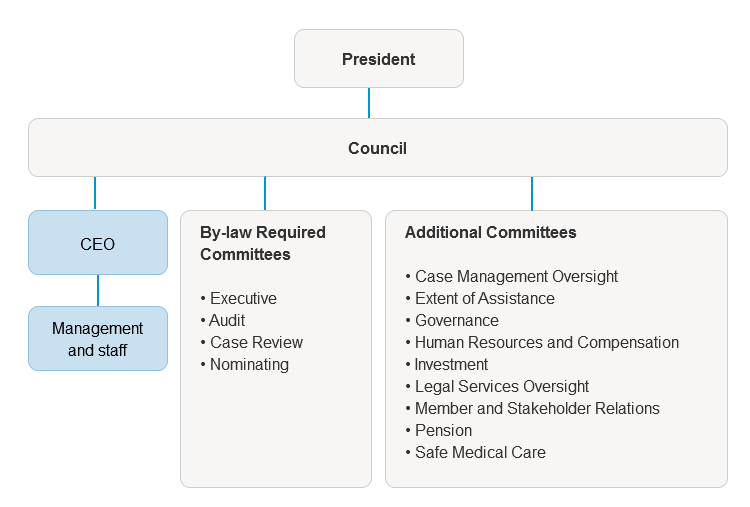Modernizing our governance
Good governance is people, process, and structures designed to improve decision making, drive success, and reduce the likelihood of poor outcomes.
We are committed to a modern CMPA that is prepared for opportunities and challenges now and in the future. To that end, we have embarked on a thorough examination of our governance model. To learn more, visit Governance review.
Current governance model
The CMPA Council is committed to responsible governance practices.
The primary purpose of the Council is to foster, through sound governance, the long-term success of the Association consistent with its Strategic Plan and responsibilities to the members.

Council and President
The CMPA is governed by an elected Council of 31 practising physicians who, working together and with CMPA management, foster the long-term success of the Association.
The Council elects the president and one or more vice-presidents. The President provides leadership in guiding the Council and coordinating its activities. Two Vice-Presidents assist the President, and have powers and duties that the president may delegate or the Council may prescribe.
Council appoints the Chief Executive Officer (CEO) and is responsible for monitoring and evaluating the CEO’s performance. Council also works collaboratively with the CEO and CMPA management to support the needs of the Association and its members.
CMPA Council meets quarterly to foster the long-term success of the Association.
Council representation and responsibilities
Council is composed of a diverse group of practising member physicians from 10 geographical areas across Canada (British Columbia and Yukon; Alberta; Saskatchewan, Northwest Territories and Nunavut; Manitoba; Ontario; Québec; New Brunswick; Nova Scotia; Prince Edward Island; and Newfoundland and Labrador).
To ensure appropriate representation across all specialties in medicine, surgery, and family medicine, elected Council members must practice in one of the following Divisions:
- Division A: Certification from the College of Family Physicians of Canada (CFPC) or the Collège des médecins du Québec (CMQ) (Specialists in Family Medicine), or physicians without CFPC, CMQ or Royal College of Physicians and Surgeons of Canada (RCPSC) certification. One (1) Council position within Division A is filled by a member engaged in a residency program in Canada.
- Division B: Specialist certification from RCPSC or CMQ, not including specialists in Family Medicine
The number of Division A or B positions in each area is determined by geographical location. In some instances, a Council position within an area may be Division A or B.
Collapse section
In accordance with the CMPA's Act of Incorporation and by-law, the Council is responsible for overseeing how the business of the Association is conducted and directing management, to whom the Council delegates the responsibilities for the day-to-day conduct of business. Article 4 of the by-law outlines the requirements of the Council.
Term of office: Councillors hold office for a three (3) year term. Their term begins as of the conclusion of the Annual Meeting. Following the three-year term, provided they remain qualified, Councillors are eligible for re-election. Councillors in office shall continue in office until their successors are elected or appointed.
The Terms of Reference for Council and Councillors sets out the way in which the Council organizes and conducts itself to fulfill its responsibilities, and describes the responsibilities of councillors.
The Council actively displays this commitment through its leadership and participation in a variety of governance activities including:
- Council evaluation—Every two years, Council assesses its effectiveness and efficiency.
- Individual personal professional development and support program—Each year, following the first year of their three-year term, new and returning councillors receive anonymous feedback from their peers. This supports personal development and helps Councillors enhance strengths and identify areas for improvement.
- Nominating Committee peer review evaluation—Each year, just prior to the end of their three-year term, committee peers evaluate all incumbent councillors seeking re-election.
- Committee structure and effectiveness review—To ensure the duties and responsibilities of all committees meet the Association's needs, Council evaluates the effectiveness of all committees every two years.
Members of Council and all non-Council committee members are required to adhere to the Association's Code of conduct and conflict of interest guidelines for councillors. This includes the requirement to review the Code of conduct and sign an acknowledgement form.
Collapse section
As specified in Article 5 of the CMPA Bylaw, the Council annually elects the President and one or more Vice-Presidents. The CMPA Council governance manual articulates the President may serve for a maximum of two years; there is no limit on the tenure for Vice-Presidents.
The mandate, duties, and responsibilities of the President and Vice-Presidents are provided in the Terms of reference for the president and vice-presidents.
Collapse section
Additional reading
Committees
Much of CMPA Council's work is delegated to the various committees. In addition, sub-committees or working groups are sometimes created to deal with strategic, time limited issues of concern.
Council establishes the membership of committees annually. Each committee is governed by terms of reference that outline its mandate, composition, duties and responsibilities, accountability, procedures, meetings, and activities.
Additional reading